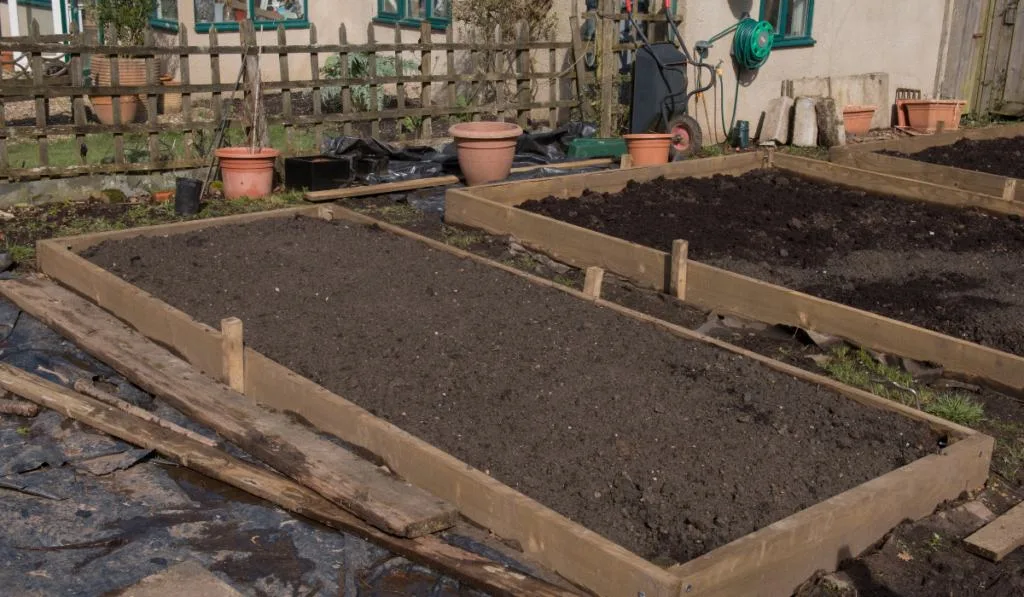As time goes by, soil particles can clump together and become compacted. The consequences of this occurrence are reduced soil aeration, drainage, nutrient distribution, and water penetration. If this happens to your soil, it becomes unfit for planting. So, what’s the solution to this? Tilling.
But what if you have raised garden beds? Do raised garden beds need tilling?
Raised garden beds do not need tilling. When building a raised bed, using rich soil and sufficient compost decreases the formation of clumps. Also, replacing the compost regularly and minimizing the use of pesticides further reduces the chances of clumping.

While you may not need to till your raised garden bed, tilling is actually a beneficial procedure. In the next few paragraphs, you’ll come to understand what tilling entails.
Table of Contents
Do Raised Garden Beds Need Tilling?
As we’ve already hinted, under appropriate circumstances, raised garden beds do not need tilling. This is unlike in-ground beds, which usually need to be tilled at the end of the growing season.
A well-prepared, raised garden bed contains rich soil and compost. These two components increase the organic matter content of your raised bed.
Now, as you use the beds, there’s no doubt that the organic matter content will fall. But if you regularly replenish it with compost, there will always be organic matter to protect the soil from erosion and nutrient depletion.
While they are useful against pests, pesticides can be harmful to beneficial living organisms (such as worms, ants, and microbes) in the soil. Normally, these organisms break down clumps as they form. But by using pesticides regularly, you’ll have less and less of them.

What Is Tilling and Why Would You Do It?
Tilling is a form of cultivation, but it goes deeper. When cultivating, you remove weeds and loosen the soil. But you only go a few inches beyond the surface of the soil.
With tilling, you do the same thing as when you cultivate, but this time you go up to 8 – 10 inches below the surface of the soil.
With new garden beds, you may even till beyond 10 inches, especially when the soil is compacted. Generally, the depth to which you till depends on the quality of the soil you have.
The process of tilling involves agitating the particles of the soil to break them down. This agitation can be achieved by mechanically digging, shaking, overturning, or stirring the soil.
You can till manually by hoeing, raking, or shoveling. You can also till the soil with machines such as harrows, plows, and rototillers.
Why Would You Till?
The main reason for tilling is to improve the soil structure by increasing aeration and water and nutrient circulation.
But besides improving the soil structure, you can also till to a lesser depth to remove weeds and to mix compost or organic matter into the soil.
Tilling helps dry the soil faster. You may till the soil to reduce moisture before seeding. You could also till to smooth the surface of your garden in anticipation of the planting season.

Pros and Cons of Tilling Your Raised Garden Beds
Pros
- Tilling makes the soil loose by breaking down clumps. When the soil is loose, drainage improves, and aeration improves.
- With improved aeration, the soil becomes better suited for living organisms. Increased activity of living organisms in the soil will aid the breakdown of organic matter and facilitate the use of nutrients.
- As drainage improves, the permeation of water through the soil improves. Improved permeation of water means more nutrients can be dissolved and distributed across the soil.
- Also, as the soil becomes loose, it makes for easy penetration of plant roots through the soil. This, in turn, improves the efficiency of nutrient absorption. Easy root penetration is particularly important for root and tuber crops.
- Tilling can help remove or destroy weeds.
- When mixing compost, fertilizer, or organic matter with the soil, tilling can help spread the mixture evenly and efficiently.
- Tilling can also help smooth the surface of your field or garden ahead of planting.
Cons
- Tilling may cause the soil to lose its ability to retain water. If this happens, the soil may lose nutrients too.
- By loosening the soil, tilling may leave the soil at risk of erosion.
- If tilling is done excessively, it may reduce the number of living organisms in the soil.
- Tilling can make the soil more desirable for harmful organisms such as slugs and armyworms.
- If not done correctly, you may accumulate plant pathogens on the surface of the soil while tilling.
- Tilling increases the surface area of the soil, and this makes the soil dry faster. If the soil becomes too dry, it becomes unfit for planting.
Summary
If you make your raised beds properly, there will be no need to till them. Rich, healthy soils contain various components that help prevent clumping and erosion. Add compost regularly to maintain soil health.
Resources
- https://mantis.com/cultivating-the-soil-why-its-important-and-how-it-differs-from-tilling
- https://www.burpee.com/gardenadvicecenter/areas-of-interest/flower-gardening/raised-beds/article10010.html
- https://extension.uga.edu/publications/detail.html
- https://encyclopedia2.thefreedictionary.com/Tilling+(agriculture)
- https://blog.gardeningknowhow.com/gardening-pros-cons/tilling-advantages-vs-no-till-advantages/
